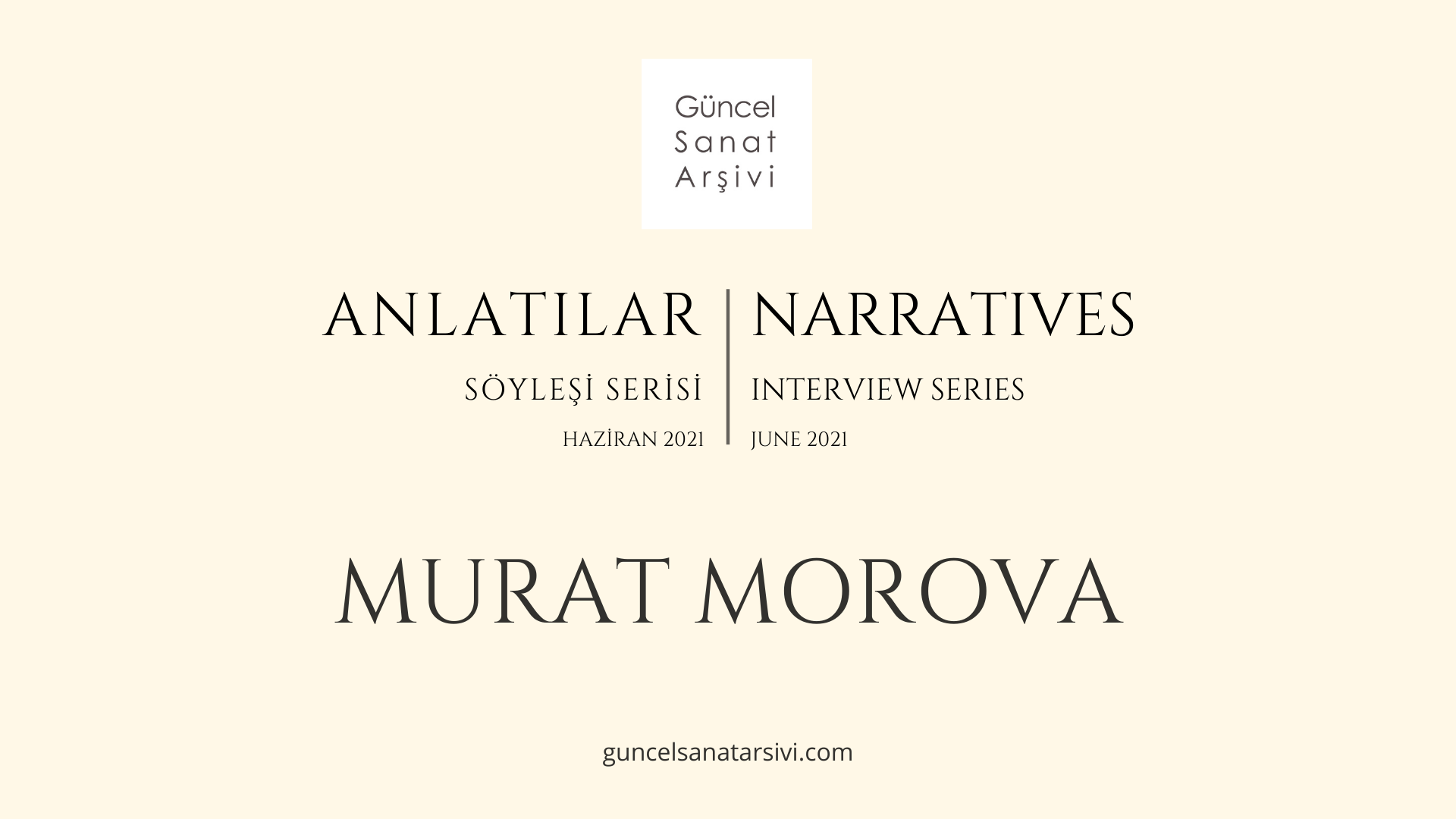Interview: Seniha Ünay / About
Translation: Burçin Nilay Kalınbayrak / About
The guest of the June issue of Narratives Interview Series is Murat Morova, an artist who combines Eastern and Western art techniques with different materials and disciplines in his works. During the interview, we talked with Morova about the “I” phenomenon and the state of being human in his works, the universe he has established for today, and his understanding of art that brings the traditional and contemporary together. We also had the opportunity to mention common and different features in terms of form, figure, concept, and technique in his production process since his first exhibition.
“When I look back now, I can say that my home is my heart.”
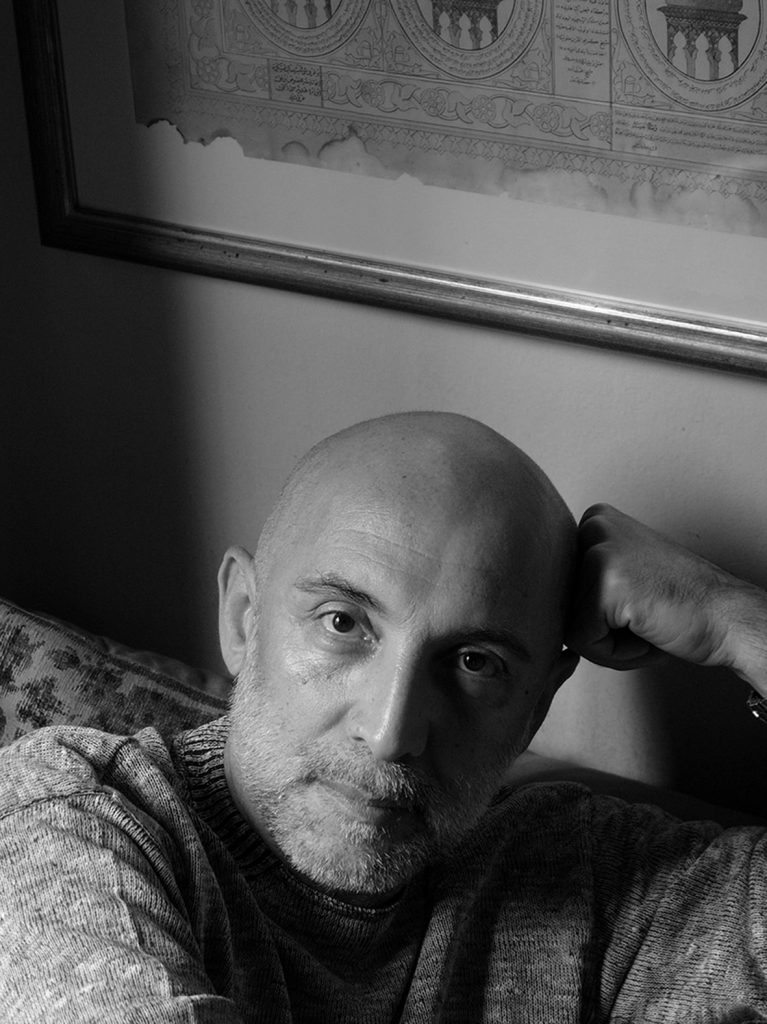
You grew up in an immigrant family that shares the coexistence of different beliefs, cultures, traditions, and customs. You graduated from the Department of Interior Architecture at Marmara University Faculty of Fine Arts, formerly known as the State School of Applied Fine Arts established based on the Bauhaus movement. We know that you worked as an interior architect for a while and then turned to art. Could you talk about the reflections of your education and childhood on your understanding of art and your decision to make a living with art?
Among the factors that affect an artist are of course the role of his/her family, home, the environment he/she was born and raised in, and the city he/she lives in. I was born in an old Istanbul house in Üsküdar, Istanbul. Before, we were a large family with grandparents, aunts, and uncles. My mother’s side comes from the Caucasus and my father’s side from the Balkans. They are two sides, two cultures who dispersed, immigrated after the Ottoman Empire, and got together in İstanbul. An atmosphere mixed with Albanian, Circassian, Georgian, and Laz people. I lost my father when I was five years old and was an only child. My mother was a working woman, so I grew up with my elderly household from whom I heard family stories, beliefs, social rituals, and habits of that generation. Both my great-grandmother and my grandmother were elegant, experienced people who were devoted to both traditional values and the principles of the Republic. The time spent with them gave me a very rich imagination from a very early age. This is very precious to me. Today, I owe these two women the first rooted and valuable vaccine of my knowledge in fields such as art, aesthetics, philosophy, politics, and mysticism. When I look back now, I can say that my home is my heart.
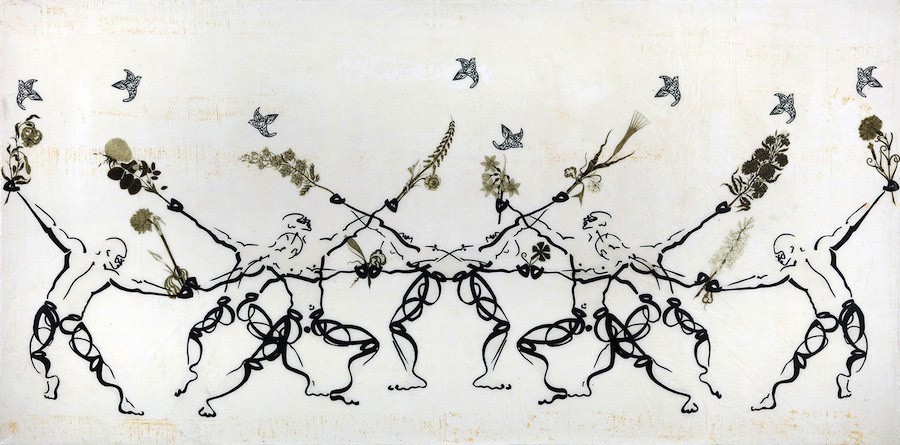
Murat Morova, “Dancers”, Mixed media on canvas, 60×120 cm, 2009.
When it comes to my art, painting, history, literature, music were the elements in my childhood playground. Also, when I felt drawn to studying art in my teenage years, I always got support. I understand that this first sensitivity and support shown in the family made a great contribution when I won and started my education at the State School of Applied Fine Arts, as formerly called. I owe first to my family how I found my way in my art practice which includes the main topics like tradition, imagination, and universality, and then to the School’s educational approach giving weight to liberal interdisciplinary work with a diversity of programs beyond academic fatigue. As you mentioned, the School was based on the Bauhaus movement. Even though I studied mainly interior architecture and design, there were the freedom of working in different workshops, and an experimental manner in the School which allowed every field to be intertwined easily. Today, my guidance for combining different materials and forms of expression is thanks to this rooted but free environment at the School. Also, the valuable contributions of the Bauhaus-disciplined German teachers shouldn’t be forgotten. Drawing, watercolor, photography, mud, carpenter, and iron workshops in the basic art education enabled me to work in both arts and crafts, which now helps me a lot.
Murat Morova, “Untitled”, Mixed media, 29.5×75.5 cm, 2013. From the exhibition “Nature Morte”, Gallery Nev, Istanbul, 14.02-29.03.2014.
“In the final analysis, I have a leftist worldview… It is a search, adventure, a state of being on the road including our stops in the cyclical time through justice, conscience, mercy, compassion that we have forgotten, and of course including the question on how we will become the “Al-Insān al-Kāmil (The Complete Person)” at the end.”
In your works, you use materials such as nylon, tar, glass fiber, and calligraphic elements on the axis of subjects such as Sufism, Mysticism, Hurufism, Sufism, Islam, and the body. As is always said, we see the reflections of formal and semantic references to tradition with a contemporary language in your works. Could you tell us about this aspect of your works? Could you also mention your perspective on the state of being human that is demonstrated in your works through the “I” phenomenon?
I am on a journey of being “on my own” without giving up whether the belief, culture, aesthetics, politics of the geography I live in or the value systematics of the West. Past, present, and future evolve in cyclical time for me. Staying in this “limbo” in my mind and in the works I want to produce also led me aesthetically to an aesthetic in limbo where the main themes are sociology of religion, time, sexuality, death, resistance to heteronormative coercion, city, history, social and individual mythologies, social and individual fascism. In the final analysis, I have a leftist worldview. Without forgetting to take along the cultural layers of both the West and the East, it is a search, adventure, a state of being on the road including our stops in the cyclical time through justice, conscience, mercy, compassion that we have forgotten, and of course including the question on how we will become the “Al-Insān al-Kāmil (The Complete Person)” at the end. Until very recently, we were surrounded by Western discourses and judgments about beauty and art. Since globalization, art now includes all cultural expressions with the contribution of postmodern thought. It is not limited to Western thought and discourse anymore. Prejudiced and stereotypical thoughts about the East in general and Islamic aesthetics in particular were stretched. There are so many differences to refute prejudices such as the prohibition of figure, sculpture, and ornaments. We can no longer exclude traditional facts from the dynamics of time.
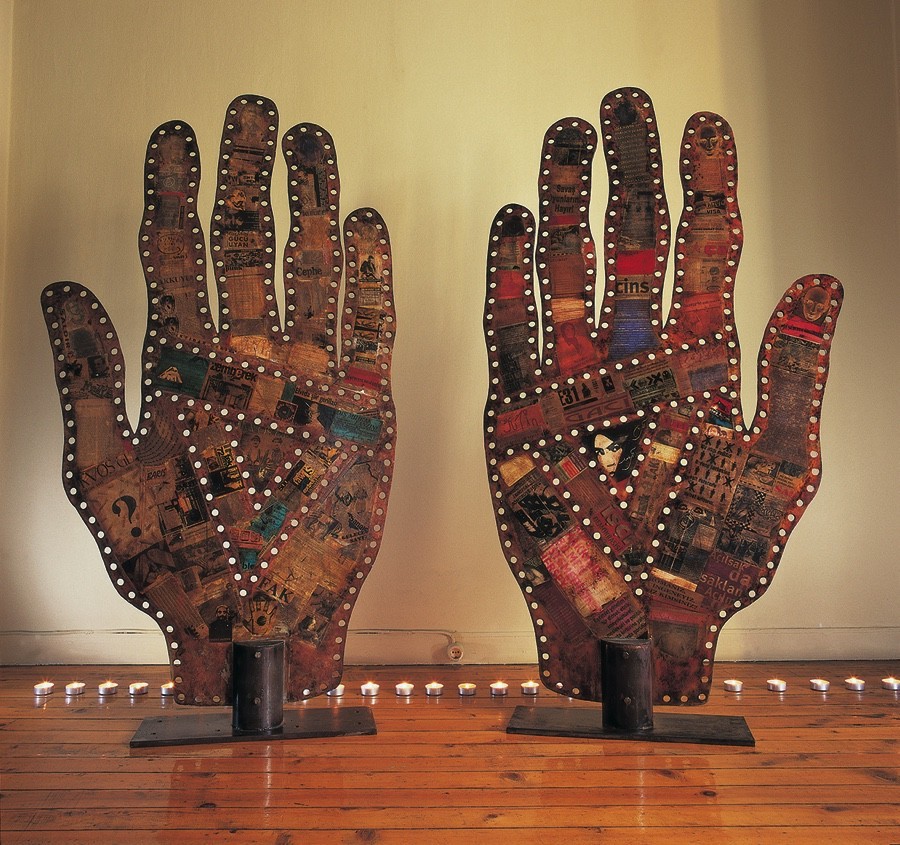
Murat Morova, “Hay(ı)r”, Collage on iron, 190×300 cm, 1997.
As I mentioned, I have a very busy mind with the sociology of religion. Shamanism, Buddhism, Mani, Zoroastrianism, early Christianity, their areas of interaction and transformation, sometimes hidden and sometimes open, when they encounter Islam, and the political and sociological reasons for these infiltrations have been a scepter, a basis that has accompanied me in my art journey since the 90s. Alevi/Bektashi corpus, Hurufism, dervish lodge paintings, glass-bottom paintings, bazaar painters, lithograph stories, etc., as different mediums other than Ottoman palace art, seemed to me as the best way to express the rebellion against some of today’s problematics. For example, what I want to do finds its clearest expression in my work “Hay(ı)r” where I transformed the Ahl al-Bayt hand form, which symbolizes a household that is told to be protected, to our current households that we marginalize and cannot protect. The iron hand form I made with the laser cut technique was the form of my own hands as an artist. I was showing on these hands all the fanzines reflecting the political, sexual, religious, marginalized thoughts (feminist, queer, Kurdish, conscientious objection, etc.) that I collected widely in the 90s. Here are the households of this country, our lines of destiny, our fingerprints. It was displayed in many national and international exhibitions. It is a work that I still stand behind today, as it shows me with all my external and internal sides. That work and the subsequent works “Naked”, “Shadow of the Skin – Body of the Soul” and “The Perfumed Garden” exhibited at the 49th Venice Biennale coincide with the period that I started working with ready-made materials. I attach great importance to the use of ready-made in terms of the discourse getting its voice from the reality of its material in daily life. Likewise, the materials of my exhibition “Nature Morte”, where I touched on the problem of environmental destruction and pollution, were coal tar, polyethylene plastic, and industrial residues. When I am talking about this work, maybe I should also share this: You can observe that I have experimented on form by remaining true to the main fields of Western art history and discipline. I experienced the results of my approaches to figure, portrait, landscape, still life, and sculpture in my exhibitions “Ah Min’el Aşk-ı Memnu” (figure), “Dem bu Dem” (portrait), “Saved Landscape”, “Forgotten Landscape” (landscape), and “Nature Morte”.

Murat Morova, “Davutoğlan Bird Sanctuary“, Mixed media on canvas, 120×240 cm, 2008. From the exhibition “Saved Landscape”, Gallery Nev, Ankara, 16.01-11.02.2009.

Murat Morova, “Forgotten Landscape”, Mixed media on canvas, 120×240 cm, 2007. From the exhibition “Forgotten Landscape, Gallery Nev Istanbul, 02.11-29.12.2009.
“In the course of time, I have seen that these works displayed in the 2nd Istanbul Biennial have contributed to the ongoing debates such as gender politics, objection to heteronormative understanding, queer art, etc.”
You began to be actively visible in art in the 1980s. The works in your exhibition “A Season in Hell” in 1988, one of your first exhibitions shaped on gender politics and identities, were the ones painted on canvas with a figurative approach. In your later works, we see photographs, installations, and sculptures besides the traditional painting. For example, we can see that in your works “Hay(ı)r” in 1997, “Property of Endurance” in 2008, “Never Again” in 2011, and “Conference of Birds” in 2016. What are the common and different features in your works since your first exhibition in terms of form, figure, and concept?
Yes, I started to be actively visible in the art world after the second half of the 80s. Before the exhibition “A Season in Hell” in 1988, my works were displayed at “Beyond the Figure”, an exhibition curated by Beral Madra in 1987. The first works based on gender politics and identities were in line with expressionism and adopted by a wide generation of young artists as the ideal oppositional form of those years. These works were painted on canvas, quickly made, colorist, and figurative. But when I look at them now, they also contain some clues like esotericism which have become prominent in my later works. In the course of time, I have seen that these works displayed in the 2nd Istanbul Biennial have contributed to the ongoing debates such as gender politics, objection to heteronormative understanding, queer art, etc. I find these works meaningful because I made more or less a contribution that paved the way for a younger generation dealing with these questions in today’s art. It should not be forgotten that the 80s-90s were a post-coup d’etat environment, and after these exhibitions with strange defamations, censorship provocations, implicit allusions, and half and timid support, I started to look intensely at my art practice through sociological, intellectual, and political initiatives and historical and cultural developments. As intuitions, experiences, and readings have matured, I realized that I could not limit my means of expression only to the possibilities of canvas and paint. Three-dimensional thinking, installation, and working with different materials were already my forms of expression which stemmed from the field of interior architecture and design that I had studied. Again, with the motivation and technical assistance of my friend Ahmet Elhan, one of the competent names in contemporary photography, I stepped into photography that I am familiar with because of my field and use now. It is possible to see photography sometimes as a digital manipulation print, and sometimes as a collage and cut out in my mixed media works. My works “Dirty Story, “The Moral”, “Never Again” are photographic prints. On the other hand, “Forgotten Landscape” and “Saved Landscape” series were mixed media.

Murat Morova, “A Season in Hell”, Oil on canvas, Two parts of the triptyque, 120×120 cm each, 1988. From the exhibition “A Season in Hell”, Urart Art Gallery, Istanbul, 1988.
“My voice is louder in my single works, but more whispering, more subtle, and fragile in my solo exhibitions. I would like an atmosphere that listens to the audience and establishes a relation with their inner voice.”
In the adventure of turning calligraphic figuration into three-dimensional works, the traditional art of papercutting sets off in the footsteps of dervish lodge calligraphy art –which are the examples of wooden decoupage– within the framework of “Solid” and more heterodox aesthetics. The interesting thing here is that the body/figure forms in my first exhibitions have been following me constantly… Sometimes calligraphic patterns, sometimes laser cut, but it always appears as a repetition of form, a difference in expression. I think my own anagraph has formed over the years. My story that I created with minimal elements may have both sameness and disparity. In Sufi aesthetics, this is called tenevvü (diversification/diversity). The same form, different material, different expressions create a chance to say something else. Of course, I also have works that inform or provoke the audience a lot, but I like the plain material that serves the form without hiding its own nature. I care that the artist’s craftsmanship is left behind and that more than technical skill and ability, the viewer can tell the work with its own inner layers. A dialogue that comes from the heart’s memory and tries to provide an intellectual space is more important to me than enchanting and surprising artworks.
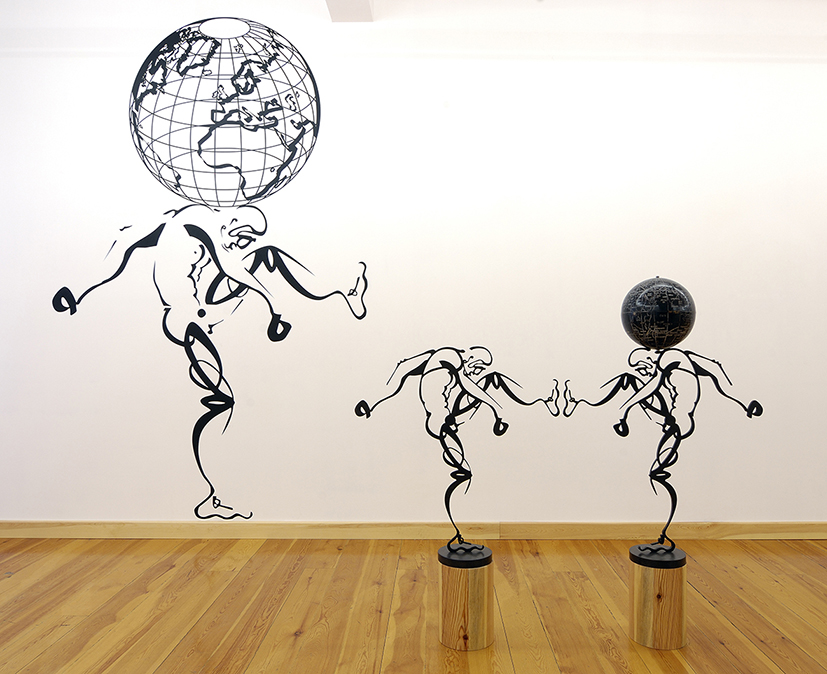
Murat Morova, “Property of Endurance”, Laser cut steel, Left: 265×165 cm, Middle and right: 75x62x19 cm, Installation View, Gallery Nev Istanbul, 2008.
It is not possible for me to give long descriptions of the works you mentioned here due to the limited space, but we can clarify that: The concepts I deal with may vary, but I guess I have a more economic loyalty in terms of form-figuration. I am not the kind of artist who works in the studio every day. The studio is a space that I use as a workshop when things are well-formed in my mind, fall into place and I concentrate only on the execution of the work. I spare more time on the conceptual side of the work. Thinking, reading, collecting notes, and then sifting through… The studio process begins with questions, which I obtain as a result of wandering in the city and internal discussions over the writers and thinkers I became close to, such as “What is the most suitable technique and material for this, what is my most suitable role for the pronunciation of the word?” My voice is louder in my single works, but more whispering, more subtle, and fragile in my solo exhibitions. I would like an atmosphere that listens to the audience and establishes a relation with their inner voice. Even in exhibitions, a project does not carry on through the singularity of the works. They are usually “installations” that have some clues about the concept I am tackling with their quantitativeness, materials selection, and spatial placement. I want the organization/hanging form to create an atmosphere over the dialogue it establishes with the audience. My exhibitions “Remz”, “Language+ Semblance”, “Saved Landscape”, “The Moral”, “Cosmic Latte” have these concerns and talk to the audience. There is a saying in Sufism, “Everyone takes as much as their own cup.” which I care about. What everyone finds in it, let it be with their own perception and knowledge; a conversation without forcing or frightening…
Murat Morova, “Untitled”, C-Print on metallic paper, 76 x 125 cm, 2010. From the Exhibition “The Moral”, Gallery Nev Istanbul, 10.12.2010-08.01.2011.
“Past, present, and future spin around not in linear time but in cyclical time, in the current color of the universe, Cosmic Latte.”
Lastly, we would like to mention your exhibition, “Cosmic Latte”, which opened at Gallery Nev Istanbul in 2019. In this exhibition, like in your other exhibitions, you use elements such as Eastern calligraphy and miniatures, and you create a universe about today. “Cosmic Latte” is a phrase used by a team of astronomers from Johns Hopkins University to describe the average color of the universe. We know that you took György Lukács’ theory as a reference in your art adventure. Could you touch on this exhibition and accordingly your production processes including the stages of reading, researching, and thinking that shape your works?

My last solo exhibition “Cosmic Latte” pretty much sums up my entire experience of 35 years. Images of universe-human, death-life, external-internal displayed in the space in a cyclical installation. There are both Eastern and Western art techniques in the works. There are the naturalistic perspective of the West and the hierarchical-mystical perspective of the East which is seen in the miniatures. Classical figures, calligraphic forms of Al-Insān al-Kāmil, Western watercolors are intertwined with the Ottoman muralist tradition. Leonardo, Dürer, German Romanticism, dervish lodge calligraphy… Past, present, and future spin around not in linear time but in cyclical time, in the current color of the universe, Cosmic Latte. This is Dem (time), that is, now is now. In this exhibition, I also gave the audience many references to my 35-year art production in written form. For me, reading and research processes are a big part of my work and I wanted to show the tips of this as well. In my early years, I was very interested in the relation between the development of form in art and the class struggle, the “Soul and Form” theory, and Lukâcs aesthetics. This idea of contrasts later helped me to see the subtlety of the differences between the Ottoman traditional arts and the heterodox dervish lodge art. In the formation of my own iconography, my choice came closer to the different belief systems in Anatolian geography, and to this language with a more free, unconventional aesthetic. Of course, the general Sufi culture and aesthetics, the philosophy and techniques of the traditional arts developed based on my imagination and my subjective reality. sway I sway from side to side, from İbnü’l-Arabî to Ferîdüddin Attâr, from Mevlana to Nazım Hikmet, from Itrî to Alevi/Bektashi sayings, from Black Sea road tones to “Requiem” by Mozart. This is a subjective reality that jumps from Malik Aksel’s “Religious Paintings of the Turkish”, from Ahmet Hamdi Tanpınar readings to the early Renaissance, from German romanticism to “Âmâk-ı Hayâl (The Depths of Imagination)” by Ahmad Hilmi of Filibe (Plovdiv).

Based on the coexistence of the mystical/hierarchical perspective of the East within the naturalist perspective of the West, the ideal body and figure understanding of the Renaissance, and the calligraphic art of this geography, my own figuration (Ah Min’el Aşk-ı Memnu) has been always formed in this obstinate/compromising environment. Looking through an intersection at hero types, calligraphic typeface, and body art, which are frequently seen in Hurufism… This figuration of my own iconography, which has now become almost ossified, has turned into images that I have used frequently. There has been the “narrative image” in almost every series, to which I entrust my entire voice. It is like the reconstruction of the elements of the two worlds by bringing forward the traditional sensation and perception.
Thank you very much for your questions. It may be deemed that I sometimes act very tacitly and sometimes it seems like I’m running away from answering, but as I said, I don’t want to take away the chance of the audience to make their own readings of the texts. I think it is necessary to avoid as much as possible from explanations full of terminology and texts that put distance between the work and the audience. After all, “Everyone takes as much as their own cup.”
Murat Morova, “Ah Min’el Aşk-ı Memnu”, Mixed media on canvas, 120×320 cm, 2004. From the exhibition, “Ah Min’el Aşk-ı Memnu”, Gallery Nev, İstanbul, 03-31.12.2004.
Our thanks are due to Murat Morova and Galeri Nev istanbul.
- For more information about Murat Morova, you may visit his website.
- The photos in this interview are courtesy of the artist and Gallery Nev Istanbul. Portrait photo by Kamil Şükun
- The rights of all the visual and textual concepts in this interview are reserved. Quotation shall be allowed provided that the source shall be mentioned in the work where the quotation is cited. For the photos please contact the artist and Gallery Nev Istanbul.
Please click for more information about Narratives Interview Series.
